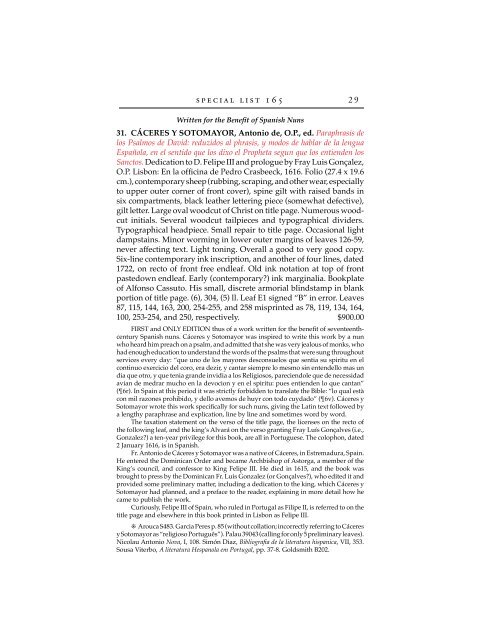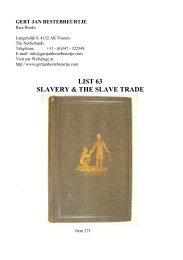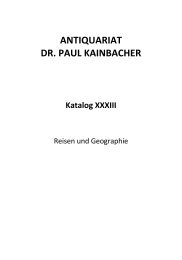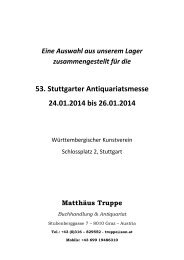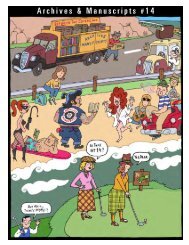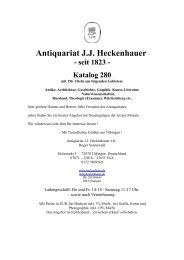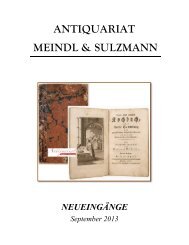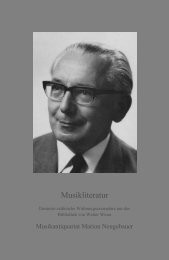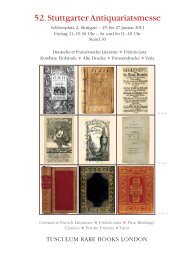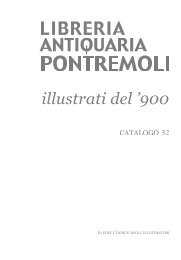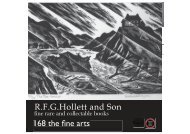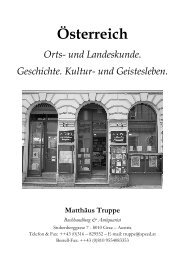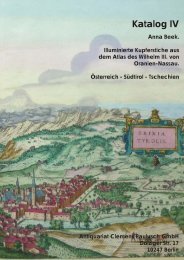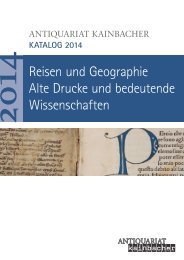Recent Acquisitions - Richard C. Ramer Old & Rare Books
Recent Acquisitions - Richard C. Ramer Old & Rare Books
Recent Acquisitions - Richard C. Ramer Old & Rare Books
You also want an ePaper? Increase the reach of your titles
YUMPU automatically turns print PDFs into web optimized ePapers that Google loves.
special list 165 29<br />
Written for the Benefit of Spanish Nuns<br />
31. CÁCERES Y SOTOMAYOR, Antonio de, O.P., ed. Paraphrasis de<br />
los Psalmos de David: reduzidos al phrasis, y modos de hablar de la lengua<br />
Española, en el sentido que los dixo el Propheta segun que los entienden los<br />
Sanctos. Dedication to D. Felipe III and prologue by Fray Luis Gonçalez,<br />
O.P. Lisbon: En la officina de Pedro Crasbeeck, 1616. Folio (27.4 x 19.6<br />
cm.), contemporary sheep (rubbing, scraping, and other wear, especially<br />
to upper outer corner of front cover), spine gilt with raised bands in<br />
six compartments, black leather lettering piece (somewhat defective),<br />
gilt letter. Large oval woodcut of Christ on title page. Numerous woodcut<br />
initials. Several woodcut tailpieces and typographical dividers.<br />
Typographical headpiece. Small repair to title page. Occasional light<br />
dampstains. Minor worming in lower outer margins of leaves 126-59,<br />
never affecting text. Light toning. Overall a good to very good copy.<br />
Six-line contemporary ink inscription, and another of four lines, dated<br />
1722, on recto of front free endleaf. <strong>Old</strong> ink notation at top of front<br />
pastedown endleaf. Early (contemporary?) ink marginalia. Bookplate<br />
of Alfonso Cassuto. His small, discrete armorial blindstamp in blank<br />
portion of title page. (6), 304, (5) ll. Leaf E1 signed “B” in error. Leaves<br />
87, 115, 144, 163, 200, 254-255, and 258 misprinted as 78, 119, 134, 164,<br />
100, 253-254, and 250, respectively. $900.00<br />
FIRST and ONLY EDITION thus of a work written for the benefit of seventeenthcentury<br />
Spanish nuns. Cáceres y Sotomayor was inspired to write this work by a nun<br />
who heard him preach on a psalm, and admitted that she was very jealous of monks, who<br />
had enough education to understand the words of the psalms that were sung throughout<br />
services every day: “que uno de los mayores desconsuelos que sentia su spiritu en el<br />
continuo exercicio del coro, era dezir, y cantar siempre lo mesmo sin entendello mas un<br />
dia que otro, y que tenia grande invidia a los Religiosos, pareciendole que de necessidad<br />
avian de medrar mucho en la devocion y en el spiritu: pues entienden lo que cantan”<br />
(6r). In Spain at this period it was strictly forbidden to translate the Bible: “lo qual està<br />
con mil razones prohibido, y dello avemos de huyr con todo cuydado” (6v). Cáceres y<br />
Sotomayor wrote this work specifically for such nuns, giving the Latin text followed by<br />
a lengthy paraphrase and explication, line by line and sometimes word by word.<br />
The taxation statement on the verso of the title page, the licenses on the recto of<br />
the following leaf, and the king’s Alvará on the verso granting Fray Luís Gonçalves (i.e.,<br />
Gonzalez?) a ten-year privilege for this book, are all in Portuguese. The colophon, dated<br />
2 January 1616, is in Spanish.<br />
Fr. Antonio de Cáceres y Sotomayor was a native of Cáceres, in Estremadura, Spain.<br />
He entered the Dominican Order and became Archbishop of Astorga, a member of the<br />
King’s council, and confessor to King Felipe III. He died in 1615, and the book was<br />
brought to press by the Dominican Fr. Luis Gonzalez (or Gonçalves?), who edited it and<br />
provided some preliminary matter, including a dedication to the king, which Cáceres y<br />
Sotomayor had planned, and a preface to the reader, explaining in more detail how he<br />
came to publish the work.<br />
Curiously, Felipe III of Spain, who ruled in Portugal as Filipe II, is referred to on the<br />
title page and elsewhere in this book printed in Lisbon as Felipe III.<br />
j Arouca S483. Garcia Peres p. 85 (without collation; incorrectly referring to Cáceres<br />
y Sotomayor as “religioso Português”). Palau 39043 (calling for only 5 preliminary leaves).<br />
Nicolau Antonio Nova, I, 108. Simón Diaz, Bibliografia de la literatura hispanica, VII, 353.<br />
Sousa Viterbo, A literatura Hespanola em Portugal, pp. 37-8. Goldsmith B202.


